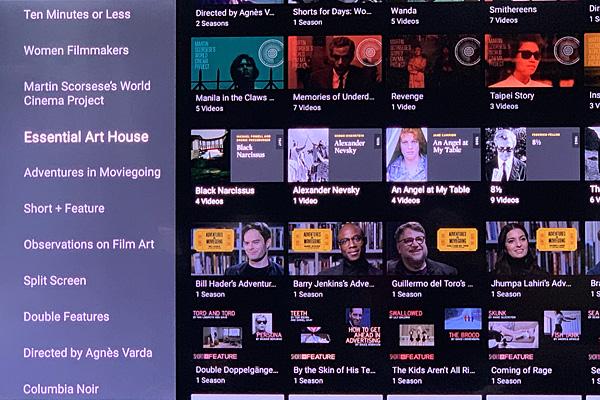Newly Launched Criterion Channel Brings Back Classic Film Streaming

The collection had been unavailable since the fall of 2018 when the FilmStruck streaming service closed down. What makes the new channel so compelling is not only the impressive list of films that are the building blocks of cinema culture and consciousness, but the supplementary content that discusses the important aspects of each film.
The Criterion Collection began as a DVD and Laser Disc company that distributed the Janus Film Library collection of classic films. Committed to the art of film, the company was an innovator in creating quality discs as it pioneered letterboxing movies, commentary soundtracks, multi-disc sets, special editions and definitive versions of films.
Criterion still makes discs, but added streaming in 2008. The Criterion Collection was available on Hulu Plus for a number of years. In fall of 2016, it left Hulu and began streaming from its own app, FilmStruck. Two years later, when AT&T bought Warner Bros. and started consolidating assets, FilmStruck met an early demise. This didn’t sit well with cinephiles and acclaimed filmmakers. According to The Los Angeles Times, Guillermo del Toro, Edgar Wright and Steven Spielberg lobbied to save the service. In less than a month, it was announced that the Criterion Channel would launch in the spring of 2019.
The Criterion Channel has launched on schedule. The new subscription online streaming app is available on iPhone, Apple TV, Android devices, Android TV, Fire TV and Roku. A subscription will run $11 a month or $100 per year.
The app offers 1,100 arthouse films. Bonus videos discuss the films, giving background, insights and little-known facts that enhance the Channel’s streaming experience. These are displayed in the main menu screen with masterpieces by Frederico Fellini, Ingmar Bergman, Sergei Eisenstein, Akira Kurosawa, Jean Cocteau, David Lean, David Lynch and others.
For example, Lynch’s Mulholland Drive has seven videos--the movie and six bonus videos. These include interviews with Lynch himself; with actors Laura Harring, Justin Theroux and Naomi Watts; with cinematographer Peter Deming and production designer Jack Fisk;, with composer Angelo Badalamenti;and a video of on-set footage.
The film descriptions go beyond simple synopses to eloquently describe the importance of the title or of a filmmaker’s work. The description of Ingmar Bergman’s Cries and Whispers explains that it is “one of Bergman’s most striking formal experiments” and that it won an Oscar for the extraordinary color photography of cinematographer Sven Nykvist. Below the descriptions are the bonus videos. For this film, Woody Allen discusses the significance of Bergman’s artistic choices, including his prolific use of red to the point where scenes faded to red and not to black. Allen explains that Bergman used red as he felt the human soul was a membrane of the body that we can see through.
To further enhance the film-viewing experience, Criterion has launched a monthly series of Observations on Film Art. Each 15-minute video explores a different filmmaking technique, showing how filmmakers have used the power of flashbacks, dissolves, continuity editing and other styles to artistically tell their story. The movie discussed is available to play from the same screen.
While the bonus videos truly make the Criterion Channel worth the price of a subscription, the streaming app’s main menu and navigation are poorly designed. It is hard to find a specific title as there is no way to search or browse film titles. Films are “thematically presented” in different categories: Tuesday Short + Feature; the Friday Double Bill; Columbia Noir includes films from the 1940s, ‘50s and 60s; Criterion Editions; Women Filmmakers; Essential Arthouse; groups of films from specific featured artists like those directed by Agnes Varda or written by screenwriter Suso Cecchi d’Amico. Martin Scorsese’s World Cinema Project category lists marginalized and infrequently screened films from areas in the world that are “ill equipped to preserve their own cinema history."
If you want to find a specific title, you can visit the Criterion Channel website, which has a search feature. By signing onto the website, you can search for a title and add it to “my list,” available on all apps. If you want to browse the available current films, you can check them out on an unofficial list of titles that a Criterion fan created.
Criterion’s Adventures in Movie Going series helps you discover specific movies, why you’d want to watch them and how they fit into the wider conversation of film culture. In interviews, directors Guillermo del Toro and Barry Jenkins, actors Bill Hader and Michael Cera, indie producer Roger Corman, movie lovers like Kareem Abdul-Jabbar an expanding list of others speak about their personal favorite titles and why they consider these films to be exceptional.
I subscribe to a lot of streaming apps and I don’t relish the idea of adding another app to that list. Still, I will be keeping Criterion Channel. Not only can I watch some of the classics I studied in film classes; I can see others I have missed. Plus, I’ll be able to learn what made each of them significant to the art of filmmaking. I’m enjoying the short (10 minutes or less) videos, which have taught me some trivia I never knew. (Did you know Orson Welles had a prosthetic nose created for each movie and character?) If you love film, the Criterion Channel is a must. There is a 14-day free trial available to give it a try.





























































